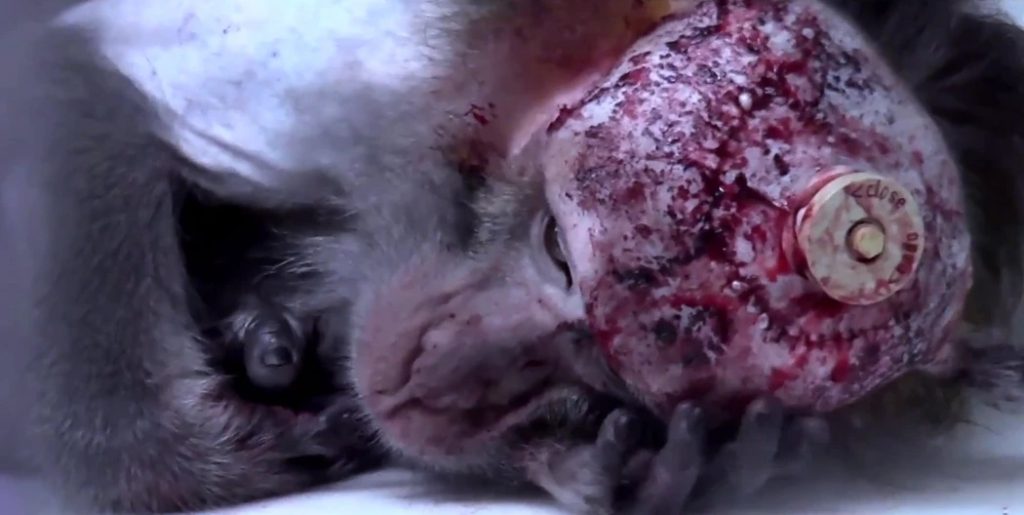Activists call the experiments carried out on macaque monkeys at the Max Planck Institute a “basic wrong.”
Under the codename Pawel, an animal rights activist worked as a nurse at the Max Planck Institute of Biological Cybernetics for over half a year, recording with a hidden camera the experiments carried out on macaque monkeys. The results of his research were just published in a video by the SOKO animal rights group called “Basic Research, Basic Wrong.”
The video and images show, among other things, what can happen to the animals when the skull of macaques is sawed open and electrodes are inserted into the brain.
First, what is called a “head holder” is surgically implanted into the monkey’s open cranium. Often these surgical wounds appear to bleed profusely.
In the video, an animal is shown trying to remove the foreign bodies from his skull. The macaque suffers from bloody wounds well into a second week after the surgery. In one case, an implant is inflamed, eventually leading to hemiplegia, which induces the monkey to vomit.
When Motherboard asked SOKO if their actions were legal, the group told us that using their clandestine Search View in the laboratory is a necessary risk, and that they have no fear of a possible criminal prosecution: “Each process brings attention to our cause and the opportunity to basic judgments against the industry,” a spokesperson said.
Laboratory animal experimentation is of course highly controversial—such experiments have yielded advances in medical and psychological science, but animal cruelty remains a pressing question. In Germany, about 3.1 million vertebrate animals were “consumed” for experimental purposes in 2012; the vast majority of which were mice and rats.
In the experiments at the Cybernetics Institute, which primarily study the neurological learning processes, water is in several cases withheld from the monkeys until some begin lick iron rods and drink their own urine, newly released video shows. They are fixed around the neck and with a rod holder on the head; after several hours, they are forced to solve tasks on the screen. Through this, the researchers hope to gain knowledge in the field of perception research. So far, the MPI has not yet replied to our request for examples of specific medical applications being developed from the basic research carried on the laboratory animals at the Institute of Biological Cybernetics.
The Max Planck Institute, meanwhile, says the activists are dramatizing their research: “The cooperation of the monkeys during the experiments is quite central to the success of our research.[…] The implants cause the animal no pain. The case is completely normal and does not show any impairment,” a spokesperson for the Institute explains. It points to videos in which the animals carry the same implants and devices, and look significantly healthier than in the images disseminated by the activists. According to the MPI, the implants would bring no change to the lives of monkeys.
The insularity of laboratory operations make it identify difficult to know, conclusively, which portrait of the animals’ welfare is more accurate; the horrifying-looking conditions shown by SOKO, or the one Max-Planck-Institute draws on its website.
The MPI told us in an e-mail, that the occurrence of “so-called seam insufficiency, according to our scientists is rare.” When we asked whether the monkeys shown ultimately all die in the laboratory, Dr. Christine Beck, Head of Science and Corporate Communications, said that “None of the animals can be released into the wild again, inasmuch, all the animals finally die in the laboratory.”
Research at Tübingen has yielded benefits for humans—medical therapies for humans, which evolved from the basic research of MPI.
On SternTV, the SOKO animal welfare spokesman Frederick Mülln responded to the MPI:
“A monkey tries to tear something out of his head, which was used to him under anesthesia, one does not need to dramatize. The pictures speak for themselves. The Max-Planck-Institute tries to downplay the reality. “
After last year’s call for an end to similar laboratory practices in experiments on rhesus monkeys, the Federal Administrative Court ruled in February 2014 that the basic research must be allowed in monkeys. Forty percent of all animal experiments in the EU are associated with the field of basic research, often funded with public money. This research is not intended to cure a disease, but the general increase of knowledge.
Ivar Aune, of the Society for Laboratory Animal Science, is on the other hand, convinced the monkeys are not being abused: “The monkeys are interested, they are like puppies that are trained.” And previously, a reporter of the Southwest German Radio had for weeks in vain, endeavored to meet with researchers at the Max Planck Institute in Tübingen .
“The truth is that animal experiments are not just harmless… but that the animals are broken and tormented in these facilities and die a cruel death,” Mülln told sternTV.
SOKO says that we need a shift towards research alternatives to invasive clinical studies, and is now calling for a demonstration at Tübingen.
Meanwhile, the 29-year-old animal rights activist Pawel incidentally received a very good reference from his former employer—they said he has always taken very conscientious care of the animals. Pawel himself says that he still often thinks of the animals and that he remains tormented by his six months in the laboratory.
Source: save-animals.info

